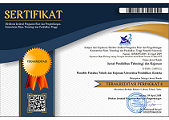PENINGKATAN AKURASI DETEKSI GARIS PANTAI MENGGUNAKAN PARTICLE SWARM OPTIMIZATION (PSO) DAN OPERASI MORFOLOGI DILASI
DOI:
https://doi.org/10.23887/jptkundiksha.v22i1.92783Keywords:
Deteksi Garis Pantai, Citra Video, Particle Swarm Optimization (PSO), Morfologi DilasiAbstract
Deteksi garis pantai menggunakan citra video semakin populer dalam pemantauan wilayah pesisir secara real-time. Citra video menangkap perubahan garis pantai secara dinamis, namun menghadapi tantangan seperti gangguan ombak, pencahayaan, dan objek non-pantai. Diperlukan metode yang lebih adaptif untuk meningkatkan akurasi deteksi. Penelitian ini bertujuan meningkatkan akurasi deteksi garis pantai dengan mengombinasikan Particle Swarm Optimization (PSO) dan operasi morfologi dilasi. PSO digunakan untuk optimasi segmentasi, sementara operasi morfologi dilasi memperjelas garis tepi dan mengurangi noise. Dataset berupa video pantai dikonversi menjadi citra statis menggunakan metode Timex, lalu dikoreksi dengan georektifikasi dan kalibrasi kamera. Tahapan utama meliputi pre-processing, segmentasi dengan PSO, serta post-segmentasi menggunakan operasi morfologi dilasi. Evaluasi menggunakan metrik PSNR, SSIM, FSIM, dan CWSSIM. Hasil penelitian menunjukkan peningkatan akurasi deteksi secara signifikan. Segmentasi berbasis PSO memisahkan daratan dan perairan dengan lebih baik, sedangkan operasi morfologi dilasi memperkuat kontinuitas garis pantai dan mengurangi noise. Peningkatan nilai evaluasi meliputi PSNR 15,87%, SSIM 9,11%, FSIM 1,20%, dan CWSSIM 2,47%, terutama dalam kondisi pencahayaan sore hari. Dengan demikian, metode ini efektif dalam deteksi garis pantai dan direkomendasikan untuk pemantauan berbasis citra video.
References
I. Rodriguez-Padilla, B. Castelle, V. Marieu, and D. Morichon, “A simple and efficient image stabilization method for coastal monitoring video systems,” Remote Sens., vol. 12, no. 1, pp. 1–21, 2020, doi: 10.3390/RS12010070.
U. Andriolo, D. Mendes, and R. Taborda, “Breaking wave height estimation from timex images: Two methods for coastal video monitoring systems,” Remote Sens., vol. 12, no. 2, 2020, doi: 10.3390/rs12020204.
D. Qiao, G. Liu, T. Lv, W. Li, and J. Zhang, “Marine vision-based situational awareness using discriminative deep learning: A survey,” J. Mar. Sci. Eng., vol. 9, no. 4, 2021, doi: 10.3390/jmse9040397.
Y. Zardoua, A. Astito, and M. Boulaala, “A survey on horizon detection algorithms for maritime video surveillance: advances and future techniques,” Vis. Comput., vol. 39, no. 1, pp. 197–217, 2023, doi: 10.1007/s00371-021-02321-0.
S. Singh, N. Mittal, H. Singh, and D. Oliva, “Improving the segmentation of digital images by using a modified Otsu’s between-class variance,” Multimed. Tools Appl., vol. 82, no. 26, pp. 40701–40743, 2023, doi: 10.1007/s11042-023-15129-y.
H. Jia, Z. Xing, and W. Song, “Three dimensional pulse coupled neural network based on hybrid optimization algorithm for oil pollution image segmentation,” Remote Sens., vol. 11, no. 9, 2019, doi: 10.3390/rs11091046.
M. Aghdami-Nia, R. Shah-Hosseini, A. Rostami, and S. Homayouni, “Automatic coastline extraction through enhanced sea-land segmentation by modifying Standard U-Net,” Int. J. Appl. Earth Obs. Geoinf., vol. 109, p. 102785, 2022, doi: https://doi.org/10.1016/j.jag.2022.102785.
M. Xu, L. Cao, D. Lu, Z. Hu, and Y. Yue, “Application of Swarm Intelligence Optimization Algorithms in Image Processing: A Comprehensive Review of Analysis, Synthesis, and Optimization,” Biomimetics, vol. 8, no. 2, 2023, doi: 10.3390/biomimetics8020235.
L. Mikkelsen et al., “Long-term sound and movement recording tags to study natural behavior and reaction to ship noise of seals,” Ecol. Evol., vol. 9, no. 5, pp. 2588–2601, 2019, doi: 10.1002/ece3.4923.
J. H. Awad and B. D. Majeed, “Overcoming camera instability problem for detecting and tracking moving objects in video using reduced data,” Indones. J. Electr. Eng. Comput. Sci., vol. 26, no. 3, pp. 1589–1598, 2022, doi: 10.11591/ijeecs.v26.i3.pp1589-1598.
E. Elkhateeb, H. Soliman, A. Atwan, M. Elmogy, K.-S. Kwak, and N. Mekky, “A Novel Coarse-to-Fine Sea-Land Segmentation Technique Based on Superpixel Fuzzy C-Means Clustering and Modified Chan-Vese Model,” IEEE Access, vol. 9, pp. 53902–53919, 2021, doi: 10.1109/ACCESS.2021.3065246.
I. Pawana, I. Widyantara, M. Sudarma, L. Linawati, and N. Wirastuti, Image Enhancement using CLAHE and Noise Removal for Shoreline Detection Framework. 2023. doi: 10.1109/ICON-SONICS59898.2023.10435197.
P. Chowdhury, N. K. G. Lakku, S. Lincoln, J. K. Seelam, and M. R. Behera, “Climate change and coastal morphodynamics: Interactions on regional scales,” Sci. Total Environ., vol. 899, p. 166432, 2023, doi: https://doi.org/10.1016/j.scitotenv.2023.166432.
W. Gao et al., “Shoreline change due to global climate change and human activity at the Shandong Peninsula from 2007 to 2020,” Front. Mar. Sci., vol. 9, no. January, pp. 1–17, 2023, doi: 10.3389/fmars.2022.1123067.
C. Kaushal, M. K. Islam, S. A. Althubiti, F. Alenezi, and R. F. Mansour, “A Framework for Interactive Medical Image Segmentation Using Optimized Swarm Intelligence with Convolutional Neural Networks,” Comput. Intell. Neurosci., vol. 2022, 2022, doi: 10.1155/2022/7935346.
S. Vasavi, M. S. Pravallika, B. N. Varun, and A. S. Sarma, “Residual network-based ocean wave modelling from satellite images using ensemble Kalman filter,” Vis. Comput., vol. 40, no. 9, pp. 6359–6368, 2024, doi: 10.1007/s00371-023-03169-2.
F. E. Nkomba, T. Kombe, and P. Ele, “Automatic urban boundary delineation in equatorial regions using SAR imagery: a comprehensive approach with decomposition, morphology, and statistical active contours,” Int. J. Adv. Comput. Res., vol. 13, no. 64, 2023, doi: 10.19101/ijacr.2023.1362004.
C. J. J. Sheela and G. Suganthi, “Morphological edge detection and brain tumor segmentation in Magnetic Resonance (MR) images based on region growing and performance evaluation of modified Fuzzy C-Means (FCM) algorithm,” Multimed. Tools Appl., vol. 79, no. 25–26, pp. 17483–17496, 2020, doi: 10.1007/s11042-020-08636-9.
Downloads
Published
Issue
Section
License
Authors who publish with the JPTK agree to the following terms:- Authors retain copyright and grant the journal the right of first publication with the work simultaneously licensed under a Creative Commons Attribution License (CC BY-SA 4.0) that allows others to share the work with an acknowledgment of the work's authorship and initial publication in this journal
- Authors are able to enter into separate, additional contractual arrangements for the non-exclusive distribution of the journal's published version of the work (e.g., post it to an institutional repository or publish it in a book), with an acknowledgment of its initial publication in this journal.
- Authors are permitted and encouraged to post their work online (e.g., in institutional repositories or on their website) prior to and during the submission process, as it can lead to productive exchanges, as well as earlier and greater citation of published work. (See The Effect of Open Access)











